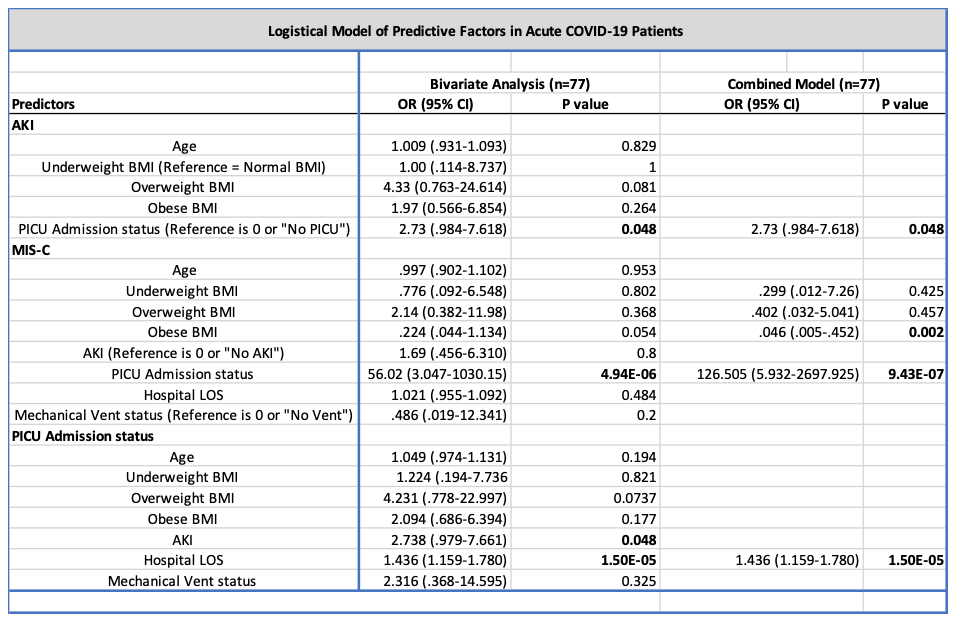Critical Care
Category: Abstract Submission
Critical Care III
114 - The Role of Underlying Childhood Obesity in Acute Presentation and Outcomes of Hospitalized COVID-19 Patients at the Children’s Hospital of San Antonio.
Sunday, April 24, 2022
3:30 PM - 6:00 PM US MT
Poster Number: 114
Publication Number: 114.307
Publication Number: 114.307
Tyler C. Tolopka, University of the Incarnate Word School of Osteopathic Medicine, Selma, TX, United States; Joshua T. Kuehne, University of Incarnate Word School of Osteopathic Medicine, San Antonio, TX, United States; Kiran K. Mainali, University of the Incarnate Word, Fort Worth, TX, United States; Morgan E. Beebe, Baylor College of Medicine, San Antonio, TX, United States; Melinda M. Garcia, Children's Hospital of San Antonio, San Antonio, TX, United States; Mohammed Salameh, Baylor College of Medicine, San Antonio, TX, United States; Rosario Ocampo, The Children's Hospital of San Antonio, Schertz, TX, United States; Utpal Bhalala, Driscoll Children’s Hospital, Corpus Christi, TX, United States

Tyler C. Tolopka, BS, MS
MS3
University of the Incarnate Word School of Osteopathic Medicine
Selma, Texas, United States
Presenting Author(s)
Background:
The novel coronavirus, SARS-CoV-2, has affected all regions, demographics, and age groups. Few studies have investigated the prevalence of childhood obesity and severe COVID presentation in a predominately Hispanic population.
Objective: Using subcategories based on patient’s BMI, we investigated the role of underlying obesity on COVID-19 presentation and outcomes at a tertiary care children’s hospital with predominate hispanic population.
Design/Methods:
We conducted a single center retrospective study that included 77 pediatric patients, 18 years and younger, hospitalized with suspected or verified COVID-19 between February 2020 and January 2021. We collected height, weight, and BMI and categorized patients based on WHO and CDC definition of obesity. We also collected demographic data, mode of presentation, need for PICU admission, severity of illness at the time of PICU admission, and data related to outcomes.We analyzed data using logistical regression with Firth’s biased reduction method wherever applicable.
Results: In our cohort, over 85% identified as Hispanic ethnicity, the median age was 8.69 years with 50.65% classified as obese (n=39). We found a significant relationship between underlying obesity and one or more co-morbidities (P=1.34E-15). Further bivariate analysis confirmed that AKI (P=.048) and MIS-C predictors (P=4.94E-06) were significant with PICU admission status. The combined model confirmed significance of both PICU admission status (P=4.42E-07) and obese BMI classification (P=0.003) on MIS-C status. PICU admission status lead to increased hospital LOS (P=1.5E-05). Age (P=0.003), underweight BMI (P=.034), and obese BMI (P=.008) were significant predictors of PICU Length of Stay. Importantly, there was a 93.5% survival rate of admitted COVID-19 patients at the Children's Hospital of San Antonio.Conclusion(s):
This single-center report described the prevalence of underlying obesity in admitted COVID-19 patients at the Children’s Hospital of San Antonio. Over 50% of pediatric patients were of obese BMI classification, predominately of Hispanic ethnicity. Obese BMI classification was significant in patient age distribution, comorbidities, MIS-C status, and PICU LOS. Hospital mortality in pediatric COVID-19 patients was low (6.49%) and consistent with literature showing lower rates of mortality in children versus mortality in adult patients with COVID-19.
Tyler Tolopka - Curriculum VitaeUIWSOM CV.pdf
Table 4. Logistical Regression of Bivariate and Combined Model Analysis of Acute COVID-19 Admitted Patients at CHOFSA.
Logistical Regression of Bivariate and Combined Model Analysis of Acute COVID-19 Admitted Patients at CHOFSA.
The novel coronavirus, SARS-CoV-2, has affected all regions, demographics, and age groups. Few studies have investigated the prevalence of childhood obesity and severe COVID presentation in a predominately Hispanic population.
Objective: Using subcategories based on patient’s BMI, we investigated the role of underlying obesity on COVID-19 presentation and outcomes at a tertiary care children’s hospital with predominate hispanic population.
Design/Methods:
We conducted a single center retrospective study that included 77 pediatric patients, 18 years and younger, hospitalized with suspected or verified COVID-19 between February 2020 and January 2021. We collected height, weight, and BMI and categorized patients based on WHO and CDC definition of obesity. We also collected demographic data, mode of presentation, need for PICU admission, severity of illness at the time of PICU admission, and data related to outcomes.We analyzed data using logistical regression with Firth’s biased reduction method wherever applicable.
Results: In our cohort, over 85% identified as Hispanic ethnicity, the median age was 8.69 years with 50.65% classified as obese (n=39). We found a significant relationship between underlying obesity and one or more co-morbidities (P=1.34E-15). Further bivariate analysis confirmed that AKI (P=.048) and MIS-C predictors (P=4.94E-06) were significant with PICU admission status. The combined model confirmed significance of both PICU admission status (P=4.42E-07) and obese BMI classification (P=0.003) on MIS-C status. PICU admission status lead to increased hospital LOS (P=1.5E-05). Age (P=0.003), underweight BMI (P=.034), and obese BMI (P=.008) were significant predictors of PICU Length of Stay. Importantly, there was a 93.5% survival rate of admitted COVID-19 patients at the Children's Hospital of San Antonio.Conclusion(s):
This single-center report described the prevalence of underlying obesity in admitted COVID-19 patients at the Children’s Hospital of San Antonio. Over 50% of pediatric patients were of obese BMI classification, predominately of Hispanic ethnicity. Obese BMI classification was significant in patient age distribution, comorbidities, MIS-C status, and PICU LOS. Hospital mortality in pediatric COVID-19 patients was low (6.49%) and consistent with literature showing lower rates of mortality in children versus mortality in adult patients with COVID-19.
Tyler Tolopka - Curriculum VitaeUIWSOM CV.pdf
Table 4.
 Logistical Regression of Bivariate and Combined Model Analysis of Acute COVID-19 Admitted Patients at CHOFSA.
Logistical Regression of Bivariate and Combined Model Analysis of Acute COVID-19 Admitted Patients at CHOFSA.